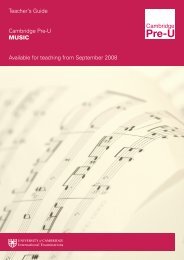Cambridge Pre-U Syllabus - Cambridge International Examinations
Cambridge Pre-U Syllabus - Cambridge International Examinations
Cambridge Pre-U Syllabus - Cambridge International Examinations
Create successful ePaper yourself
Turn your PDF publications into a flip-book with our unique Google optimized e-Paper software.
36<br />
4.3 Reproduction<br />
Content<br />
Pollination<br />
Fertilisation<br />
Seeds and fruit<br />
<strong>Cambridge</strong> <strong>Pre</strong>-U Draft<br />
Learning outcomes<br />
Candidates should be able to:<br />
a) state what is meant by the terms self-pollination and cross-pollination and explain the advantages and<br />
disadvantages of each (including reference to inbreeding)<br />
b) explain the means by which flowering plants transfer the male gametes and ensure that they arrive in<br />
the correct place for fertilisation limited to:<br />
• wind pollination including adaptations of anthers, pollen and stigmatic surface<br />
• insect pollination including reference to UV light, guides, nectar, odours, imitation of female insects<br />
• chemotropic growth of pollen tube to embryo sac<br />
c) outline the role of meiosis in the development of pollen and embryo sacs and of mitosis in the formation<br />
of gametes<br />
d) explain the significance of double fertilisation in flowering plants and describe the development of seeds<br />
and fruits (including one endospermous seed and one non-endospermous seed).<br />
Practical learning outcomes<br />
Candidates should be able to:<br />
i) investigate pollination mechanisms and pollen structure as well as growth of the pollen tube in living<br />
pollen<br />
ii) investigate a variety of flowers showing a range of adaptations (e.g. wind pollination and insect<br />
pollination)<br />
iii) investigate the structure of seeds and fruits using specimens of endospermous seeds, such as maize,<br />
and non-endospernous seeds, such as those of legumes.<br />
iv) Investigate seed and fruit development using fresh specimens and prepared slides of Shepherd’s purse,<br />
Capsella bursa-pastoris.

















